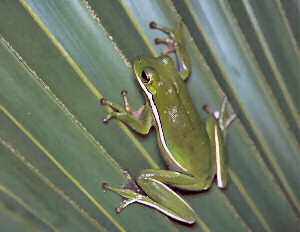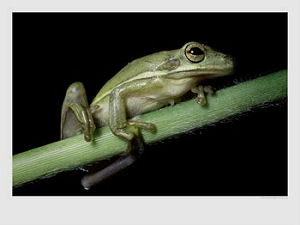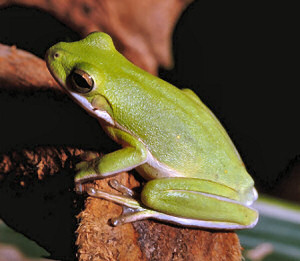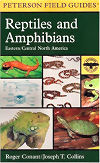
HOME
INTRO
SYMBOLS
ALMANAC
ECONOMY
GEOGRAPHY
STATE MAPS
PEOPLE
FORUM
NEWS
COOL SCHOOLS
STATE QUIZ
STATE LINKS
BOOK STORE
MARKETPLACE
GUESTBOOK
CONTACT US


Tweet
Double click on word for definition.
Louisiana State Amphibian

Louisiana State Amphibian: Green Treefrog
Photograph: Jane M. Rohling, U.S. Fish and Wildlife Service
On April 12, Louisiana State Senators Jon D. Johnson and John J. Hainkel introduced Senate Bill 435 promoting adoption of the green treefrog, Hyla cinerea, as the official state amphibian of Louisiana. The bill was a result of a yearlong contest held at the Louisiana Nature and Science Center where student visitors voted for their favorite amphibian. The Gulf Coast Herpetological Society also played a role in ensuring that Louisiana had an official state amphibian.
On its way to final approval in the Louisiana Senate, the green treefrog had to overcome an amendment to Senate Bill 435 introduced by Senator Willie Crain. His amendment replaced the green treefrog with the bullfrog. "The bullfrog is easily seen and you can certainly hear them," Crain said. Senator James Cox asked whether an alligator wouldn't be a more suitable symbol. He backed down when he learned that alligators were reptiles, not amphibians.
The amendment to replace the green treefrog with a bullfrog was approved, but later overridden when Senator Johnson's amendment to restore the green treefrog to Senate Bill 435 was adopted. The bullfrog promotor, Senator Willie Crain, was absent from the Senate at the time time of this vote.
On May 13, 1993, the Louisiana Senate voted 30-7 to adopt the green treefrog as the official state amphibian of Louisiana and sent the bill on to the House for their approval.
Unfortunately, the bill ran into trouble in the House as well. Though it was approved in committee and quickly put to a floor vote by the members of the House, the bill failed to pass on June 4, 1993. Noting that 24 members of the House were absent when this vote took place, the bill was re-submitted to a vote on June 9. This time, the House voted 56-42 to adopt the green treefrog as the official state amphibian of Louisiana.
On June 9, Senate Bill 435 was signed by the Speaker of the House. On June 10, Senate Bill 435 was signed by the President of the Senate and on June 22, 1993, the legislation was signed by Governor Edwin W. Edwards.
About the Green Treefrog

Louisiana State Amphibian: Green Treefrog
Green Treefrog [ Treefrog prints ]
The green treefrog is considered to be the one of the most beautiful tree frogs in North America. Its color ranges from bright, leaf green to olive green. A yellow to white stripe runs from its jaw along each side to its hip. Hyla cinerea grows to be about 1 3/4 to 2 1/2 inches long. Its legs are about 1 1/2 times as long as its body, which helps it to jump from 8 to 10 feet when desired. Its toes end in round pads that allow it to climb around in trees very comfortably.
Green treefrogs are found in swamps, borders of lakes and bayous, on floating vegetation, in trees and bushes near water, in Spanish moss or under bark on trees, and any place well supplied with water or dampness. At night they can be found clinging to house windows or windowsills preying on insects attracted by the artificial light.

Louisiana State Amphibian: Green Treefrog
In spring (by May) adult male treefrogs get out and about looking for mates. Their evening calls have been described as sounding like banging a cowbell with a stick. Some compare the sound to the words "Duck! Duck!" or "Quank! Quank!" The sounds they make give rise to some other names for the Green Treefrog; Cowbell Frog; Bell Frog; and Fried Bacon Frog among them. Where green treefrogs are plentiful, one can look forward to a grand chorus ever year from sometime in May through July.
The green treefrog is such an impressive specimen, that the incomparable Kermit the Frog was modeled after it. From the wilds of Louisiana to a TV Star on the Hollywood Walk of Fame is not a bad accomplishment for a little green treefrog.
Louisiana Law
The following information was excerpted from the Louisiana Revised Statutes, Title 49. Note that the name of the official amphibian is misspelled in the legislation. It reads "green tree frog" where it should read "green treefrog".
TITLE 49. STATE ADMINISTRATION.
SECTION 49.169.1. STATE AMPHIBIAN
§ 169.1. State amphibian There shall be an official state amphibian. The official state amphibian shall be the green tree frog. Its use on official documents of the state and with the insignia of the state is hereby authorized.
Acts 1993, No. 815, § 1.
Sources...
"Louisiana Revised Statutes." Louisiana State Legislature. 2004. 19 December 2004
Louisiana Secretary of State. 2004. 19 December 2004
The Times-Picayune. 1993. April-June 1993.
Shearer, Benjamin F. and Barbara S. State Names, Seals, Flags and Symbols: A Historical Guide Third Edition, Revised and Expanded. Westport, Conn: Greenwood Press, 3 Sub edition, 2001.
Additional Information
Green Treefrog: University of Florida - Wildlife ecology and conservation
Green Treefrog (Hyla cinerea): Amphibian Species Descriptions from the Southeast Amphibian Research and Monitoring Initiative.
Hyla cinerea (green treefrog): University of Michigan Museum of Zoology: Animal Diversity Web.
Green Tree Frog (Hyla cinerea): Amphibiancare.com is a collection of articles, care sheets, photographs, and resources related to the captive care and understanding of amphibians and reptiles.
State amphibians: Complete list of official state amphibians.
More symbols & emblems: Complete list of official Louisiana state symbols.
What is an Amphibian? (The Science of Living Things) , by Bobbie Kalman and Jacqueline Langille, 32 pages, Crabtree Publishing Company (2000). Reading level: Ages 9-12. The large, full-color photographs and illustrations that pepper every page of these books will catch the eye of browsers but it is the informative, easy-to-read texts that will hold their interest.
Peterson First Guide to Reptiles and Amphibians , by Robert C. Stebbins, Joseph T. Collins and Roger Conant. Edited by Roger Tory Peterson. 128 pages, Houghton Mifflin Harcourt (April 15, 1999). From mudpuppies to rattlesnakes, this fascinating guide for young nature lovers describes the habits and habitats of these secretive and sometimes bizarre animals, and includes tips on how to catch and care for frogs, snakes, turtles, lizards, salamanders, and toads.

A Field Guide to Reptiles & Amphibians of Eastern & Central North America, by Roger Conant and Joseph T. Collins, 640 pages, Houghton Mifflin Harcourt; Fourth Edition edition (May 15, 1998). This newly designed field guides features detailed descriptions of 595 species and subspecies. The 656 full-color illustrations and 384 drawings show key details for accurate identification. More than 100 color photographs and 333 color photographs and 333 color distribution maps accompany the species descriptions.
Firefly Encyclopedia of Reptiles and Amphibians, edited by Tim Halliday and Kraig Adler, 240 pages, Firefly Books (September 7, 2002). With lush color photographs and lavishly detailed illustrations, this encyclopedia presents a striking abundance of information at a glance. Also noteworthy is the scholarly text, a comprehensive overview of these frequently studied phyla.
Care and Breeding of Popular Treefrogs: A Practical Manual for the Serious Hobbyist, by Philippe de Vosjoli, Robert Mailloux, Drew Ready. 205 pages, Advanced Vivarium Systems (January 1, 1997) This book is written by experienced and recognized frog herpetoculturists and focuses on the care of popular tree frogs now sold in significant numbers. It covers many important topics that are required knowledge for successful keeping. Acclimating imported species, housing, feeding and captive breeding are included. A practical manual for the serious hobbyist.
Frogs, Toads, and Treefrogs: Everything About Selection, Care, Nutrition, Breeding, and Behavior, by R. D. Bartlett and Patricia P. Bartlett. 104 pages. Barron's Educational Series (February 1, 1996) This manual includes detailed instructions for maintaining a proper terrarium, taking preventative measures against parasites and disease, ensuring a healthful diet for your amphibians, profiles of popular species, and more.
Reptiles & Amphibians for Dummies, by Patricia Bartlett, 360 pages, For Dummies; 1st edition (June 1, 2003) This essential guide tells you what you must know before you own a reptile or amphibian, with authoritative advice on everything from proper caging and feeding to health care, socializing, transporting, and more. You'll find out about the different species, normal and abnormal behavior, the basics of breeding, and complying with laws.

